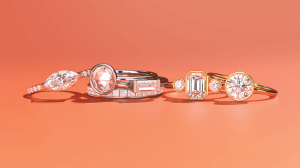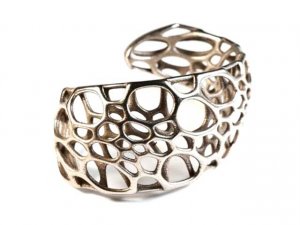Kegan Fisher is an experienced founder with experience in mass customization and 3D printing at Shapeways and SOLS (acquired in 2017 by Aetrex Worldwide). Fisher was recognized on Forbes’ ‘30 Under 30’ list for 2015 and .inc Magazine’s ’30 Under 30’ list for 2015. She has been featured in Business Insider’s ‘30 Most Important Women under 30 in Tech’ list. She holds a B.S. in industrial design and manufacturing from the Pratt Institute.
Give us some background on your experience and how you have gotten this far.
At Shapeways I helped designers build businesses with 3D printing. After that, at SOLS I built technology that produced custom 3D printed insoles using an iOS app, computer vision, and machine learning. Now, at Frank Darling, I’m making ethically sourced and sustainably grown customized diamond jewelry you can try on at home — for free. I believe making products more personal is the key to making fewer, better products that are more sustainable, and ultimately more satisfying.
What are your thoughts on the merging of tech and fashion in terms of additive manufacturing processes?
What I find most exciting about additive manufacturing’s influence on fashion is the ability to create products that are tailor-made for the individual. Making products on demand, rather than mass producing them is keeping overstock out of landfills, and it makes products more timely, and more unique. That’s what fashion is all about. At Frank Darling, our products are zero waste. Every ring is made on demand from recycled gold, because there’s just no need or excuse for new gold mining. Each ring is custom designed for a perfect fit to both finger and gemstone. Returns are one of the big challenges with custom products, but we can offer free returns because we melt down the gold and reclaim every material that goes into the ring. Soon, we’ll even be 3D printing our rings directly in precious metals like gold and platinum, rather than using lost wax casting. The design possibilities 3D printing opens up for fine jewelry are endless.
Explain some of the work you currently are doing at Frank Darling.
When my partner and I first looked at the diamond industry as customers, everything about it seemed old-school. The whole industry has focused on marketing to men. Women’s considerations have been in the background for a long time. We wanted to really address some of those challenges, which is why we made low-profile settings that don’t get in the way, a try at home experience that’s more approachable than a jewelry store, and high-quality low-maintenance materials. Today, 66% of couples are shopping together so this is a huge shift happening right now, and we see that leading to a more gratifying experience for everyone. With both partners going through the process together, that makes personalization even more important and exciting.
Why is the thought process of sustainability so valued in the current ideals of the fashion industry?
I think that for people working in apparel especially, the scale that things are being produced at can be mind boggling when you see it with your own eyes. As consumers, we don’t really get exposed to what chemicals and dyes are used to produce clothing, what that does to water, and what happens to all those clothes when they don’t sell. For people working in fashion, I think it can be hard to ignore. Jewelry is the same, even though the physical scale might not be as daunting, mining enough gold for a single ring means processing 20 tons of earth. With consumers valuing sustainability more and more, there’s a positive synergy between brands and consumers that share those ideals. From what we’ve seen, the demand for lab-grown diamonds is growing four times faster than mined diamonds, which is much faster than people were expecting a couple years ago, and I think that shows that the environment is a priority, especially for millennial and gen z.
How do you feel about the concept of a circular economy attached to the world of fashion?
I think circular economies are a natural evolution for fashion. Designers have always gone back to previous decades for inspiration, combining something old with something new. The combination is exciting. We completely recycle materials and reusing them to produce new pieces with little to no waste, and even though recycled diamonds are most commonly the result of death, debt, or divorce, we find consumers are less squeamish than they used to be about that, and value the fact that the materials had a past life. Everyone loves it when products have a story behind where they come from, so I feel like the more fashion designers and companies can create innovative products that have a second or third life to them, or use raw materials that skipped a landfill and went right back into the marketplace, there’s not just environmental interest, there’s a lot of intrigue for the story behind the product as well.
What are some essential skillsets for anyone who wants to be at the intersection of technology and fashion?
This is tricky because technology and fashion in some ways use two entirely different disciplines and different parts of the brain. I think one of the things that has always been exciting about Francis Bitonti’s work is how his technological approach to fashion made products and showpieces that could only be designed by someone with a deep knowledge of additive manufacturing. In footwear, excluding some of the athletic brands, I’ve been consistently shocked at how low tech the design process is. CAD is barely used at most brands, if at all, which means there’s a tremendous opportunity for people who understand the possibilities that 3D technology and new manufacturing processes opens up for design. Most of the big brands aren’t able to leverage them yet.
Give us some insight on how the process of creating Lady Gaga’s heels went.
I really had to reach for this one. You’re making me realize how long I’ve been doing this. Lady Gaga’s heels were a great (but maybe not so practical) first step towards showcasing the potential for additive manufacturing in fashion.
3D Printed Bracelet from Shapeways
What are some interesting projects and initiatives that you see coming within the additive and fashion world?
Like I mentioned earlier, the 3D printing of precious metals like gold and platinum is so new, and jewelry is so old, the chance to shake up what you can do with the design is very exciting. It also shortens the supply chain and allows custom products to be made at more accessible price points.
What advice do you have for anyone who is trying to be great in their own craft?
Any craft takes time to master. When I became interested in fine jewelry, I had a lot of catch-up learning to do. Everything I’d learned about footwear production was pretty useless. I felt like a fraud for the first year. The only shortcut I can think of is to surround yourself with knowledgeable people, and soak up as much as you can. Now I finally feel like I know much more about fine jewelry than I ever did about shoes. That took two years. You need to be patient.
Subscribe to Our Email Newsletter
Stay up-to-date on all the latest news from the 3D printing industry and receive information and offers from third party vendors.
You May Also Like
3D Printing Financials: Fathom Struggles in Financial Quicksand During Critical Transition
Facing a year of key transitions and financial pressures, Fathom (Nasdaq: FTHM) has filed its annual report for 2023 with the U.S. Securities and Exchange Commission (SEC). The document outlines...
Latest Earnings Overview for Australian 3D Printing Firms Titomic and AML3D
Australian 3D printing manufacturing firms Titomic (ASX: TTT) and AML3D (ASX: AL3) reported their financial results for the period from July to December 2023, marking the first half of their...
3D Printing Webinar and Event Roundup: April 7, 2024
Webinars and events in the 3D printing industry are picking back up this week! Sea-Air-Space is coming to Maryland, and SAE International is sponsoring a 3D Systems webinar about 3D...
3D Printing Financials: Unpacking Farsoon and BLT’s 2023 Performance
In the Chinese 3D printing industry, two companies, Farsoon (SHA: 688433) and Bright Laser Technologies, or BLT (SHA: 688333), have recently unveiled their full-year earnings for 2023. Farsoon reported increases...



































